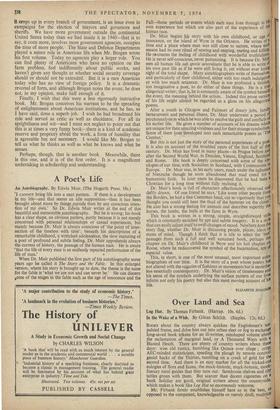A Poet's Life
An Autobiography. By Edwin Muir. (The Hogarth Press. 18s.) CANNOT bring life into a neat pattern. If there is a development In my life—and that seems an idle supposition—then it has been brought about more by things outside than by any conscious inten- tion of my own.' So Dr. Edwin Muir writes at the end of this beautiful and memorable autobiography. But he is wrong; his book has a clear shape, an obvious pattern, partly because it is not merely concerned with personal relationships or casual experiences, but mainly because Dr. Muir is always conscious of 'the point of inter- section of the timeless with time'; beneath his descriptions of a remarkable childhood, a wretched adolescence, the slow maturing of a poet of profound and subtle feeling, Dr. Muir apprehends always the current of history, the passage of the human race. He is aware 'that the life of every man is an endlessly repeated performance of the
life of man.' •
When Dr. Muir published the first part of his autobiography some years ago he called it The Story and the Fable. In this enlarged version, where his story is brought up to date, the theme is the same for the fable is 'what we are not and can never be.' He can discern some of the stages in the fable such as the age of innocence and the Fall—those periods or events which each man lives through in Ith, own experience but which are also part of the experience of th' human race. Dr. Muir begins his story with his own childhood, or age 4 innocence, on the island of Wyre in the Orkneys. He writes of ,11 time and a place where man was still close to nature, where eac° season had its own ritual of sowing and reaping, mating and killing. He re-creates the feeling of childhood with wonderful truthfulness', He is never self-conscious, never patronising. It is because Dr. MP' sees all human life sub specie aeternitatis that he is able to write 01 his own past life as if he were still living it, yet without ever losing sight of the total shape. Many autobiographers write of themselves+ and particularly of their childhood, either with too much indulgenca or with too much reticence. Dr. Muir is too profound a thinkerf too imaginative a poet, to do either of these things. He is a trtll ' allegorical writer; that is, he is constantly aware of the symbol beneot° the event, the meaning behind the action. Indeed this prose versioe, of his life might almost be regarded as a gloss on his allegorical poems.
After a youth in Glasgow and Fairport of dreary jobs, famill,
bereavement and personal illness, Dr. Muir underwent a period 01, psychoanalysis in which he was able to resolve the guilt and conflicts 01 his earlier life. He gives a number of accounts of his dreams which are unique for their amazing vividness and for their strange symbolist'''. Some of them later developed into such remarkable poems as 'Ills Combat.'
But this is not just the story of the personal experiences of a poet
It is also an account of the troubled years or the first half of till! century. Dr. Muir has lived in many places—in Prague before ano, after the Second World War, in Dresden, Vienna, England, Scotian and Rome. His book is deeply concerned with some of the idee ologies of our time, with Socialism in Scotland, with Communism iS Europe. Dr. Muir was, in his early years, much under the influence of Nietzsche though he soon abandoned that mad creed for a humanistic faith. In later years he discovered that he had been a Christian for a long time without fully realising it.
Dr. Muir's book is full of characters affectionately observed and deftly drawn. Of one friend he says, 'Like some other people front the Borders, he had a fine Caesarean head, cut so vigorously that you, thought you could still hear the thud of the hammer on the chisel. He also has a strong feeling for animals and describes superbly Ills horses, the lambs, the bulls at the farm in Wyre. This book is written in a strong, simple, straightforward styli
which is constantly enriched by apt and subtle imagery. It is a stY11 that can easily adjust itself to swift changes of mood. Nowhere does the story flag, whether Dr. Muir is discussing people, places, ideas 01 states of mind. Though I think that it is idle to select the ' bests passages from such a full and well sustained book, perhaps chapter on Dr. Muir's childhood in Wyre and his last chapter 0°, Rome, where he rediscovered the symbol of the Incarnation, are 01 especial value.
This, in short, is one of the most unusual, most important auto' biographies of our time. It is the story of a poet whose poetry has not altered with the vagaries of fashions or movements but is neverthi; less essentially contemporary. Dr. Muir's vision of timelessness an" his sense of the symbols underlying the surface pattern of our live. inform not only his poetry but also this most moving account of his life.


































































 Previous page
Previous page